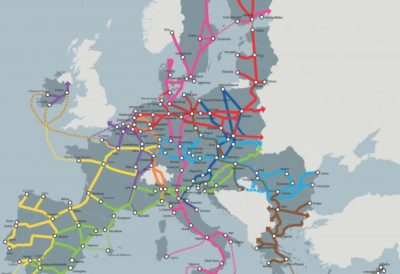TEN-T regulation proposal
24 May 2022
INE overall welcomes the proposal for regulation.
- With regard to inland waterways, the proposal takes into account to a large extent the needs of waterway authorities to help create a reliable and resilient network.
- Whereas the current guidelines are more focused on increasing capacity, INE welcomes the fact that this proposal enables to improve the quality and performance of the network as well.
- INE also welcomes the new approach by the Commission to define infrastructure requirements:
- The chosen term ‘navigable channel depth’ is an objective infrastructure parameter which can be monitored, while the current guidelines refer to the ECMT resolution which uses vessel parameters such as ‘draught’ which depend on the type of vessels and their load factor;
- The reference water levels on the basis of the number of days provide the possibility to take account of the hydro-morphology of waterways.
However, INE recommends to clarify and improve Section 2 on Inland waterway transport infrastructure with regard to the terminology and the procedures.
With regard to the terminology, INE has two proposals
1. The term ‘Good Navigation Status’ (art. 22.2) should not only cover the protection and the non-deterioration of the minimum infrastructure requirements and levels of services (art. 22.3(a)). The notion of Good Navigation Status should also cover the protection and the non-deterioration of the current status of the waterway network which may be higher than the minimum requirements and levels of services proposed in the legislation. The current status of the waterway network should not be left to deteriorate but be appropriately maintained.
2. The term ‘river basin’ building on the definition of the water framework directive is in our opinion not the right way forward in TEN-T and its transport corridors. On the one hand, river basins are broader and contain non-navigable sections. On the other hand, for transport, certain waterways/waterway sections located in one river basin are linked up to waterways/waterway sections located in other river basins. Moreover, canals cannot always be unequivocally allocated to a single river basin. We therefore propose that minimum requirements and levels of service (art. 22.3) and complementary minimum requirements (art. 22.5) as well as eventual exemptions (art. 22.4) are set out per European Transport Corridor. The corridor method allows a coherent approach across borders which fits into the TEN-T logic, whereby the European Transport Corridors enable Member States to achieve a coordinated and synchronised approach with regard to investment in infrastructure.
With regard to the procedures, we propose a corridor approach which allows an economic and coherent use of implementing acts. The current formulation in article 22 of the proposal for regulation could lead to 3 or more implementing act per river basin, ie one for the minimum infrastructure requirements (art. 22.3(a)), one or more for eventual exemptions (art. 22.4) and one for the complementing minimum requirements (art. 22.5). This would involve a serious administrative overload for all public stakeholders involved.
We propose the following corridor approach for the implementing acts with regard to waterways:
- Per European Transport Corridor, there is one implementing act pursuant to art. 54(1) covering the rivers, canals and lakes in its geographic catchment area that enable at least the navigation of vessels with a length of 80-85m and a width of 9.5m.
- This implementing act sets out he minimum infrastructure requirements and levels of services (art. 22.3(a)), eventual exemptions (art. 22.4) and the complementary minimum requirements (art. 22.5).
- The work for inland waterways becomes part of the work plans as proposed in article 53 and a revision could take place every four years in that framework when appropriate:
In general, we would welcome an enhanced role of the coordinators to ensure a coherent planning and investment approach in the European Transport Corridors.





